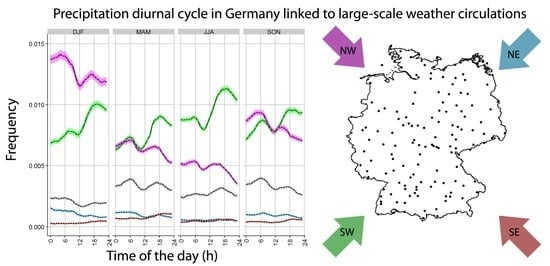Precipitation Diurnal Cycle in Germany Linked to Large-Scale Weather Circulations
Abstract
1. Introduction
- How do PDC patterns vary with CTs over Germany?
- How does seasonality and location within Germany influence such a variation?
2. Materials and Methods
2.1. Data Sources and Analysis Tools
2.2. Precipitation Diurnal Cycle (PDC) Indicators
3. Results
3.1. PDC Variation with Season and Location
3.2. Precipitation Linked to Wind Direction (WD)
3.3. PDC with WD
4. Discussion
5. Conclusions
- Precipitation occurs most frequently in winter and least in summer. However, the precipitation amount is the highest in summer and the lowest in winter and spring.
- The more continental eastern part of Germany witnesses lower values of precipitation frequency and amount than the rest of Germany. Southern high-elevation stations receive higher precipitation frequencies and amounts than the others.
- The PDC generally has a bimodal distribution with one morning peak in the precipitation frequency and another afternoon peak. The morning peak in the precipitation amount is small compared to the afternoon peak. The pattern of the PDC shows only small differences with location and elevation.
- The PDC shows clear differences between the two most frequent WDs. The SW days have a high afternoon peak and a lower morning peak. The NW days have a high morning peak and a lower afternoon peak. This applies to both precipitation frequency and amount.
- The SW days end with higher levels of both precipitation frequency and amount than the early morning. The opposite applies for the NW.
- The PDC differences between seasons are dominated by the frequency of each WD per season.
Supplementary Materials
Author Contributions
Funding
Acknowledgments
Conflicts of Interest
References
- Dai, A. Global Precipitation and Thunderstorm Frequencies. Part II: Diurnal Variations. J. Clim. 2001, 14, 1112–1128. [Google Scholar] [CrossRef]
- Dai, A.; Giorgi, F.; Trenberth, K.E. Observed and model-simulated diurnal cycles of precipitation over the contiguous United States. J. Geophys. Res. 1999, 104, 6377–6402. [Google Scholar] [CrossRef]
- Twardosz, R. Diurnal variation of precipitation frequency in the warm half of the year according to circulation types in Kraków, South Poland. Theor. Appl. Climatol. 2007, 89, 229–238. [Google Scholar] [CrossRef]
- Yang, G.Y.; Slingo, J. The Diurnal Cycle in the Tropics. Mon. Weather Rev. 2001, 129, 784–801. [Google Scholar] [CrossRef]
- Wallace, J.M. Diurnal Variations in Precipitation and Thunderstorm Frequency over the Conterminous United States. Mon. Weather Rev. 1975, 103, 406–419. [Google Scholar] [CrossRef]
- Dai, A.; Trenberth, K.E. The Diurnal Cycle and Its Depiction in the Community Climate System Model. J. Clim. 2004, 17, 930–951. [Google Scholar] [CrossRef]
- Crutzen, P.J.; Lawrence, M.G. The Impact of Precipitation Scavenging on the Transport of Trace Gases: A 3-Dimensional Model Sensitivity Study. J. Atmos. Chem. 2000, 37, 81–112. [Google Scholar] [CrossRef]
- Bohn, T.J.; Whitney, K.M.; Mascaro, G.; Vivoni, E.R. A Deterministic Approach for Approximating the Diurnal Cycle of Precipitation for Use in Large-Scale Hydrological Modeling. J. Hydrometeorol. 2019, 20, 297–317. [Google Scholar] [CrossRef]
- Arnaud, P.; Lavabre, J. Coupled rainfall model and discharge model for flood frequency estimation. Water Resour. Res. 2002, 38, 11-1–11-11. [Google Scholar] [CrossRef]
- Slingo, J.; Inness, P.; Neale, R.; Woolnough, S.; Yang, G. Scale interactions on diurnal toseasonal timescales and their relevanceto model systematic errors. Ann. Geophys. 2003, 46. [Google Scholar] [CrossRef]
- Randall, D.A.; Wood, R.A.; Bony, S.; Colman, R.; Fichefet, T.; Fyfe, J.; Kattsov, V.; Pitman, A.; Shukla, J.; Srinivasan, J.; et al. Climate models and their evaluation. In Climate Change 2007: The Physical Science Basis. Contribution of Working Group I to the Fourth Assessment Report of the IPCC (FAR); Cambridge University Press: Cambridge, UK, 2007; p. 608. [Google Scholar]
- Love, B.S.; Matthews, A.J.; Lister, G.M.S. The diurnal cycle of precipitation over the Maritime Continent in a high-resolution atmospheric model. Q. J. R. Meteorol. Soc. 2011, 137, 934–947. [Google Scholar] [CrossRef]
- Zhang, Y.; Chen, H.; Wang, D. Robust Nocturnal and Early Morning Summer Rainfall Peaks over Continental East Asia in a Global Multiscale Modeling Framework. Atmosphere 2019, 10, 53. [Google Scholar] [CrossRef]
- Im, E.S.; Eltahir, E.A.B. Simulation of the diurnal variation of rainfall over the western Maritime Continent using a regional climate model. Clim. Dyn. 2018, 51, 73–88. [Google Scholar] [CrossRef]
- Mooney, P.A.; Broderick, C.; Bruyère, C.L.; Mulligan, F.J.; Prein, A.F. Clustering of Observed Diurnal Cycles of Precipitation over the United States for Evaluation of a WRF Multiphysics Regional Climate Ensemble. J. Clim. 2017, 30, 9267–9286. [Google Scholar] [CrossRef]
- Xie, S.; Wang, Y.C.; Lin, W.; Ma, H.Y.; Tang, Q.; Tang, S.; Zheng, X.; Golaz, J.C.; Zhang, G.J.; Zhang, M. Improved Diurnal Cycle of Precipitation in E3SM with a Revised Convective Triggering Function. J. Adv. Model. Earth Syst. 2019, 11, 2290–2310. [Google Scholar] [CrossRef]
- Li, Q.; Yang, G. Temporal Distribution Characteristics of Alpine Precipitation and Their Vertical Differentiation: A Case Study from the Upper Shule River. Water 2017, 9, 284. [Google Scholar] [CrossRef]
- Zhu, X.; Zhang, Q.; Sun, P.; Singh, V.P.; Shi, P.; Song, C. Impact of urbanization on hourly precipitation in Beijing, China: Spatiotemporal patterns and causes. Glob. Planet. Chang. 2019, 172, 307–324. [Google Scholar] [CrossRef]
- Svensson, C.; Jakob, D.; Reed, D.W. Diurnal characteristics of heavy precipitation according to weather type at an upland site in Scotland. Int. J. Climatol. 2002, 22, 569–585. [Google Scholar] [CrossRef]
- Froidurot, S.; Molinié, G.; Diedhiou, A. Climatology of observed rainfall in Southeast France at the Regional Climate Model scales. Clim. Dyn. 2018, 51, 779–797. [Google Scholar] [CrossRef]
- Mandapaka, P.V.; Germann, U.; Panziera, L. Diurnal cycle of precipitation over complex Alpine orography: Inferences from high-resolution radar observations. Q. J. R. Meteorol. Soc. 2013, 139, 1025–1046. [Google Scholar] [CrossRef]
- Panziera, L.; Gabella, M.; Germann, U.; Martius, O. A 12-year radar-based climatology of daily and sub-daily extreme precipitation over the Swiss Alps. Int. J. Climatol. 2018, 38, 3749–3769. [Google Scholar] [CrossRef]
- Yaqub, A.; Seibert, P.; Formayer, H. Diurnal precipitation cycle in Austria. Theor. Appl. Climatol. 2011, 103, 109–118. [Google Scholar] [CrossRef]
- Rysman, J.F.; Lemaître, Y.; Moreau, E. Spatial and Temporal Variability of Rainfall in the Alps–Mediterranean Euroregion. J. Appl. Meteorol. Climatol. 2016, 55, 655–671. [Google Scholar] [CrossRef]
- Meredith, E.P.; Ulbrich, U.; Rust, H.W. The Diurnal Nature of Future Extreme Precipitation Intensification. Geophys. Res. Lett. 2019, 46, 7680–7689. [Google Scholar] [CrossRef]
- Ramos, A.M.; Barriopedro, D.; Dutra, E. Circulation weather types as a tool in atmospheric, climate, and environmental research. Front. Environ. Sci. 2015, 3. [Google Scholar] [CrossRef]
- Ghada, W.; Buras, A.; Lüpke, M.; Schunk, C.; Menzel, A. Rain Microstructure Parameters Vary with Large-Scale Weather Conditions in Lausanne, Switzerland. Remote Sens. 2018, 10, 811. [Google Scholar] [CrossRef]
- Schiemann, R.; Frei, C. How to quantify the resolution of surface climate by circulation types: An example for Alpine precipitation. Phys. Chem. Earth Parts A B C 2010, 35, 403–410. [Google Scholar] [CrossRef]
- Åström, H.L.A.; Sunyer, M.; Madsen, H.; Rosbjerg, D.; Arnbjerg-Nielsen, K. Explanatory analysis of the relationship between atmospheric circulation and occurrence of flood-generating events in a coastal city. Hydrol. Process. 2016, 30, 2773–2788. [Google Scholar] [CrossRef]
- Twardosz, R. Analysis of hourly precipitation characteristics in Kraków, southern Poland, using a classification of circulation types. Hydrol. Res. 2009, 40, 553–563. [Google Scholar] [CrossRef]
- Prudhomme, C.; Genevier, M. Can atmospheric circulation be linked to flooding in Europe? Hydrol. Process. 2011, 25, 1180–1190. [Google Scholar] [CrossRef]
- Nied, M.; Pardowitz, T.; Nissen, K.; Ulbrich, U.; Hundecha, Y.; Merz, B. On the relationship between hydro-meteorological patterns and flood types. J. Hydrol. 2014, 519, 3249–3262. [Google Scholar] [CrossRef]
- Kyselý, J.; Huth, R. Changes in atmospheric circulation over Europe detected by objective and subjective methods. Theor. Appl. Climatol. 2006, 85, 19–36. [Google Scholar] [CrossRef]
- Kučerová, M.; Beck, C.; Philipp, A.; Huth, R. Trends in frequency and persistence of atmospheric circulation types over Europe derived from a multitude of classifications. Int. J. Climatol. 2017, 37, 2502–2521. [Google Scholar] [CrossRef]
- Shepherd, T.G. Atmospheric circulation as a source of uncertainty in climate change projections. Nat. Geosci. 2014, 7, 703–708. [Google Scholar] [CrossRef]
- Plavcová, E.; Kyselý, J. Projected evolution of circulation types and their temperatures over Central Europe in climate models. Theor. Appl. Climatol. 2013, 114, 625–634. [Google Scholar] [CrossRef]
- Stryhal, J.; Huth, R. Trends in winter circulation over the British Isles and central Europe in twenty-first century projections by 25 CMIP5 GCMs. Clim. Dyn. 2019, 52, 1063–1075. [Google Scholar] [CrossRef]
- Panziera, L.; Giovannini, L.; Laiti, L.; Zardi, D. The relation between circulation types and regional Alpine climate. Part I: Synoptic climatology of Trentino. Int. J. Climatol. 2015, 35, 4655–4672. [Google Scholar] [CrossRef]
- Twardosz, R. A synoptic analysis of the diurnal cycle of thunderstorm precipitation in Kraków (Southern Poland). Int. J. Climatol. 2009, 30, 1008–1013. [Google Scholar] [CrossRef]
- Deutscher Wetterdienst. Description of the Method and the Weather Types. Available online: https://www.dwd.de/EN/ourservices/wetterlagenklassifikation/beschreibung.html?nn=495490&lsbId=520444 (accessed on 9 September 2019).
- Deutscher Wetterdienst. Weather Type Classification Data. Available online: https://www.dwd.de/EN/ourservices/wetterlagenklassifikation/online_wlkdaten.txt?view=nasPublication&nn=495490 (accessed on 9 September 2019).
- Deutscher Wetterdienst. Historical Hourly Station Observations of Precipitation for Germany. Available online: ftp://opendata.dwd.de/climate_environment/CDC/observations_germany/climate/hourly/precipitation/historical/ (accessed on 9 September 2019).
- Deutscher Wetterdienst. List of Precipitation Observation Stations in Germany. Available online: ftp://opendata.dwd.de/climate_environment/CDC/observations_germany/climate/hourly/precipitation/historical/RR_Stundenwerte_Beschreibung_Stationen.txt (accessed on 9 September 2019).
- Joss, J.; Tognini, E. Ein automatisch arbeitender Ombrograph mit grossem Auflsungsvermgen und mit fernbertragung der Messwerte. PAGEOPH 1967, 68, 229–239. [Google Scholar] [CrossRef]
- Deutscher Wetterdienst. Vorschriften und Betriebsunterlagen Nr. 3 (VuB 3): Technikhandbuch (THB) Für Wettermeldestellen des Synoptisch-Klimatologischen Mess- und Beobachtungsnetzes. Available online: https://www.dwd.de/DE/leistungen/pbfb_verlag_vub/pdf_einzelbaende/vub_3_thb_gesamt_pdf.pdf?__blob=publicationFile&v=5 (accessed on 9 September 2019).
- R Core Team. R: A Language and Environment for Statistical Computing; The R Foundation: Vienna, Austria, 2018; Available online: https://www.R-project.org/ (accessed on 12 September 2019).
- R Studio Team. R Studio: Integrated Development Environment for R.; R Studio Team: Boston, MA, USA, 2016; Available online: http://www.rstudio.com/ (accessed on 12 September 2019).
- Cooper, N. Reader: Suite of Functions to Flexibly Read Data from Files. 2017. Available online: https://CRAN.R-project.org/package=reader (accessed on 12 September 2019).
- Marek Gagolewski. R Package Stringi: Character String Processing Facilities. 2018. Available online: http://www.gagolewski.com/software/stringi/ (accessed on 12 September 2019).
- Wickham, H. Ggplot2: Elegant Graphics for Data Analysis; Springer: New York, NY, USA, 2016; ISBN 978-3-319-24277-4. [Google Scholar]
- Grolemund, G.; Wickham, H. Dates and Times Made Easy with lubridate. J. Stat. Softw. 2011, 40, 1–25. [Google Scholar] [CrossRef]
- Bivand, R.; Lewin-Koh, N. Maptools: Tools for Handling Spatial Objects. 2018. Available online: https://CRAN.R-project.org/package=maptools (accessed on 12 September 2019).
- Hijmans, R.J. Raster: Geographic Data Analysis and Modeling. 2017. Available online: https://CRAN.R-project.org/package=raster (accessed on 12 September 2019).
- Wickham, H. Reshaping Data with the reshape Package. J. Stat. Softw. 2007, 21, 1–20. [Google Scholar] [CrossRef]
- Wickham, H.; François, R.; Henry, L.; Müller, K. Dplyr: A Grammar of Data Manipulation. 2018. Available online: https://CRAN.R-project.org/package=dplyr (accessed on 12 September 2019).
- Jeong, J.H.; Walther, A.; Nikulin, G.; Chen, D.; Jones, C. Diurnal cycle of precipitation amount and frequency in Sweden: Observation versus model simulation. Tellus A Dyn. Meteorol. Oceanogr. 2011, 63, 664–674. [Google Scholar] [CrossRef]
- Wickham, H. Ggplot2. Elegrant Graphics for Data Analysis, 2nd ed.; Sievert, C., Ed.; Springer: Basel, Switzerland, 2016; ISBN 9783319242750. [Google Scholar]
- van der Ent, R.J.; Savenije, H.H.G.; Schaefli, B.; Steele-Dunne, S.C. Origin and fate of atmospheric moisture over continents. Water Resour. Res. 2010, 46, 61. [Google Scholar] [CrossRef]
- Yu, R.; Xu, Y.; Zhou, T.; Li, J. Relation between rainfall duration and diurnal variation in the warm season precipitation over central eastern China. Geophys. Res. Lett. 2007, 34, L13703. [Google Scholar] [CrossRef]
- Xiao, C.; Yuan, W.; Yu, R. Diurnal cycle of rainfall in amount, frequency, intensity, duration, and the seasonality over the UK. Int. J. Climatol. 2018, 38, 4967–4978. [Google Scholar] [CrossRef]
- Ahrens, C.D. Essentials of Meteorology. An Invitation to the Atmosphere, 5th ed.; Thomson Brooks/Cole: Belmont, CA, USA, 2008; ISBN 0495119040. [Google Scholar]
- Mass, C. The Topographically Forced Diurnal Circulations of Western Washington State and Their Influence on Precipitation. Mon. Weather Rev. 1982, 110, 170–183. [Google Scholar] [CrossRef]
- Svensson, C.; Jakob, D. Diurnal and seasonal characteristics of precipitation at an upland site in Scotland. Int. J. Climatol. 2002, 22, 587–598. [Google Scholar] [CrossRef]
- Oki, T.; Musiake, K. Seasonal Change of the Diurnal Cycle of Precipitation over Japan and Malaysia. J. Appl. Meteorol. 1994, 33, 1445–1463. [Google Scholar] [CrossRef]
- Landin, M.G.; Bosart, L.F. The Diurnal Variation of Precipitation in California and Nevada. Mon. Weather Rev. 1989, 117, 1801–1816. [Google Scholar] [CrossRef][Green Version]
- Li, J.; Yu, R.; Zhou, T. Seasonal Variation of the Diurnal Cycle of Rainfall in Southern Contiguous China. J. Clim. 2008, 21, 6036–6043. [Google Scholar] [CrossRef]
- Kubota, H.; Nitta, T. Diurnal Variations of Tropical Convection Observed during the TOGA-COARE. JMSJ 2001, 79, 815–830. [Google Scholar] [CrossRef][Green Version]
- Mori, S.; Jun-Ichi, H.; Tauhid, Y.I.; Yamanaka, M.D.; Okamoto, N.; Murata, F.; Sakurai, N.; Hashiguchi, H.; Sribimawati, T. Diurnal Land–Sea Rainfall Peak Migration over Sumatera Island, Indonesian Maritime Continent, Observed by TRMM Satellite and Intensive Rawinsonde Soundings. Mon. Weather Rev. 2004, 132, 2021–2039. [Google Scholar] [CrossRef]
- Chen, X.; Zhang, F.; Zhao, K. Diurnal Variations of the Land–Sea Breeze and Its Related Precipitation over South China. J. Atmos. Sci. 2016, 73, 4793–4815. [Google Scholar] [CrossRef]
- Zheng, Y.; Gong, Y.; Chen, J.; Tian, F. Warm-Season Diurnal Variations of Total, Stratiform, Convective, and Extreme Hourly Precipitation over Central and Eastern China. Adv. Atmos. Sci. 2019, 36, 143–159. [Google Scholar] [CrossRef]
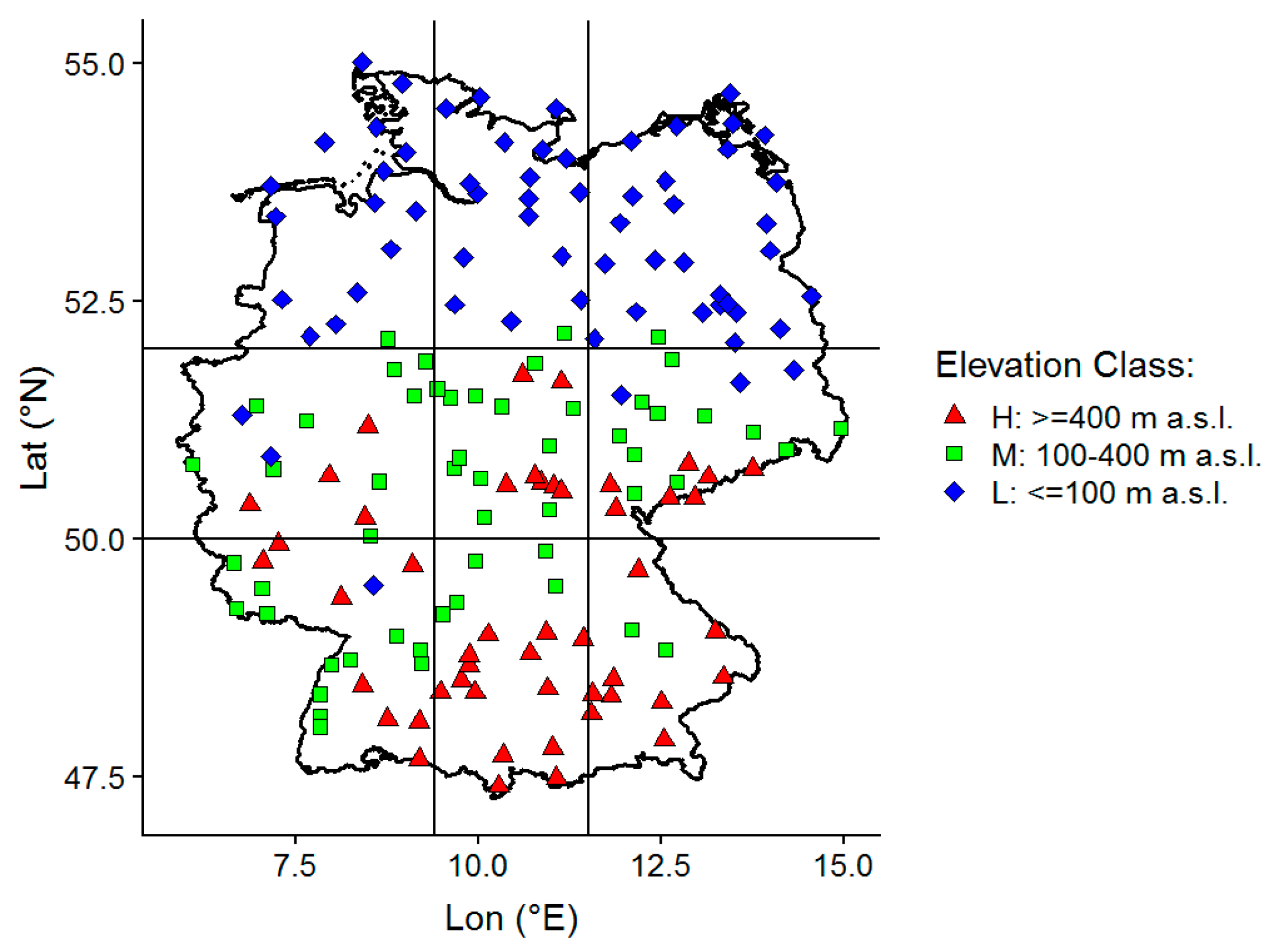
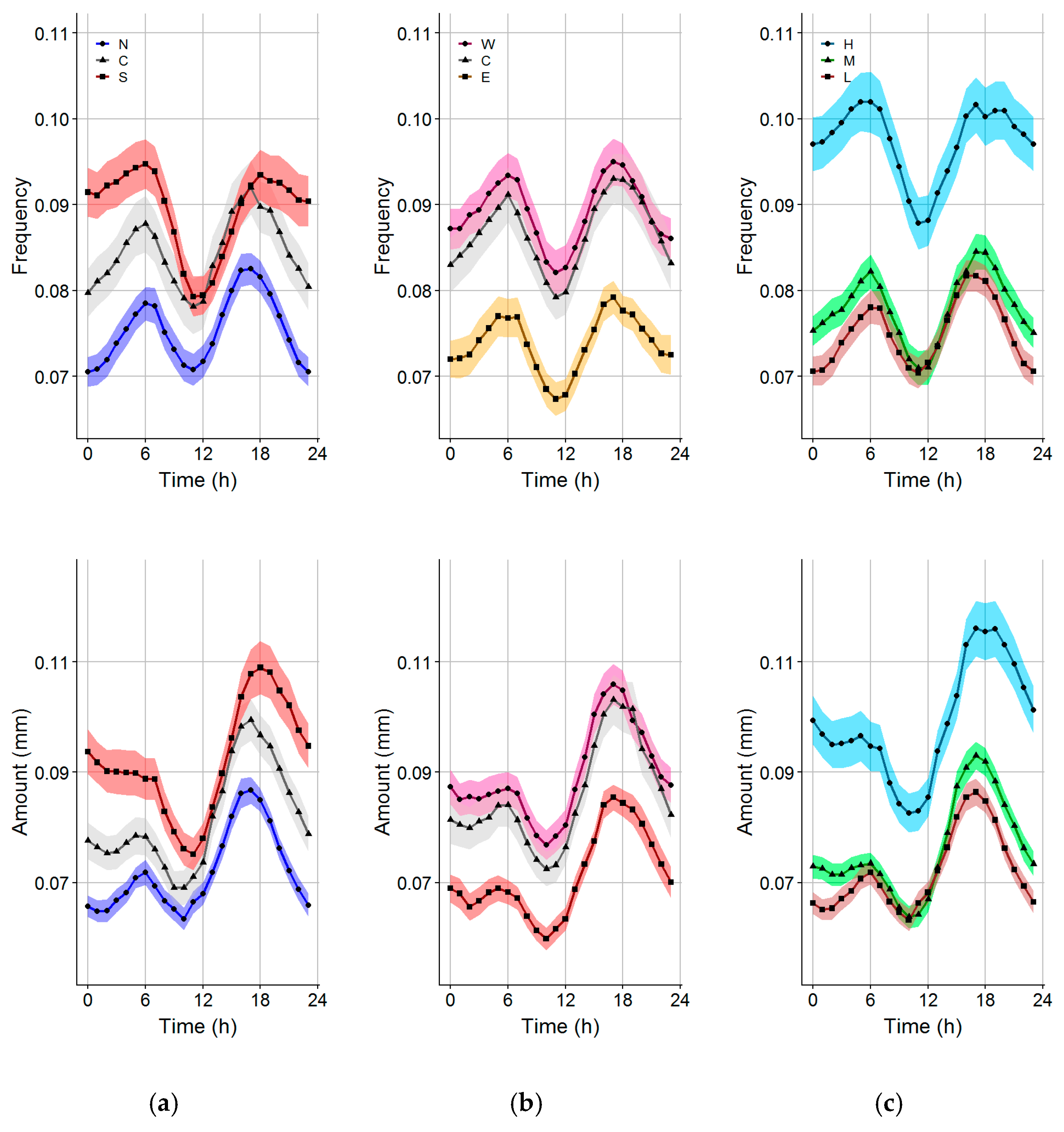
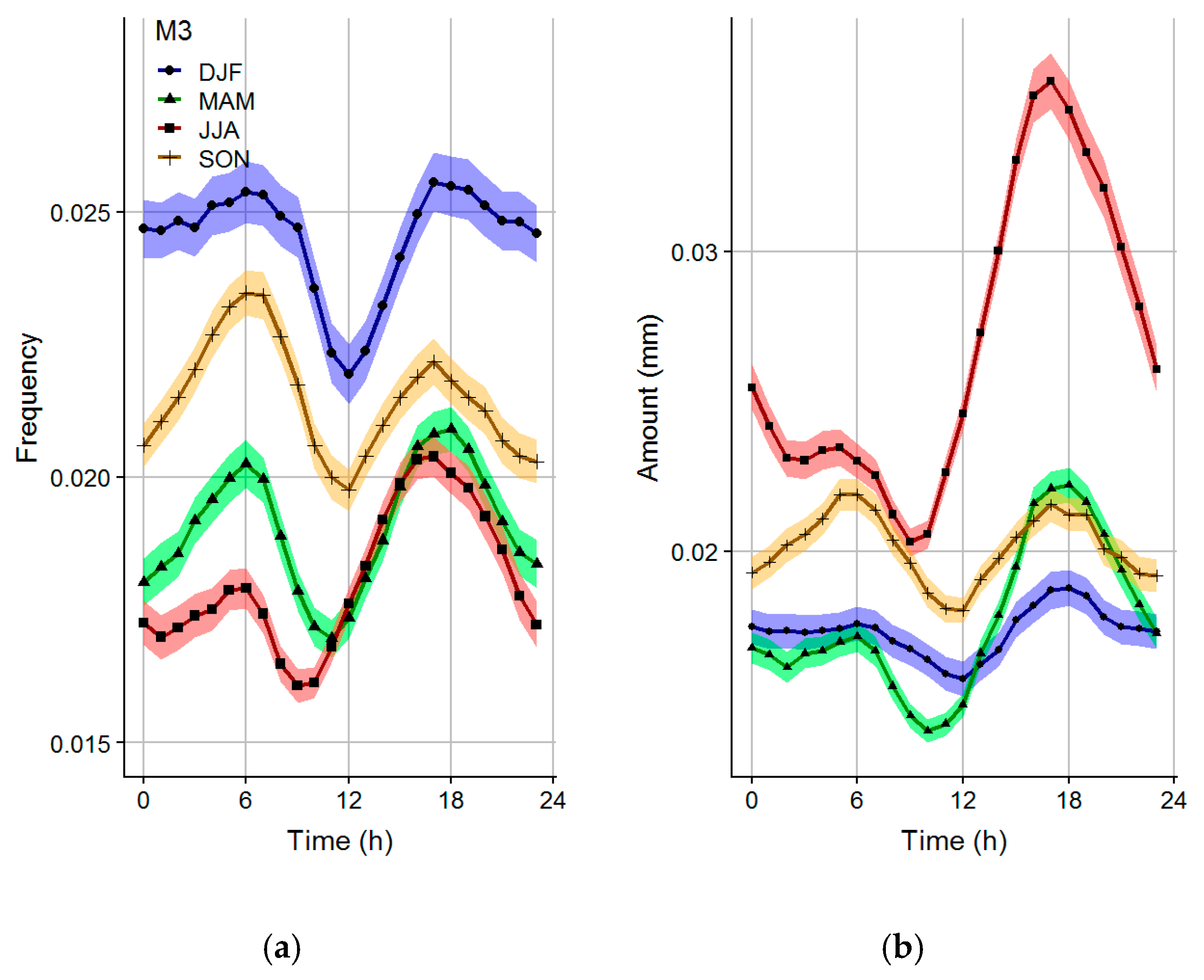
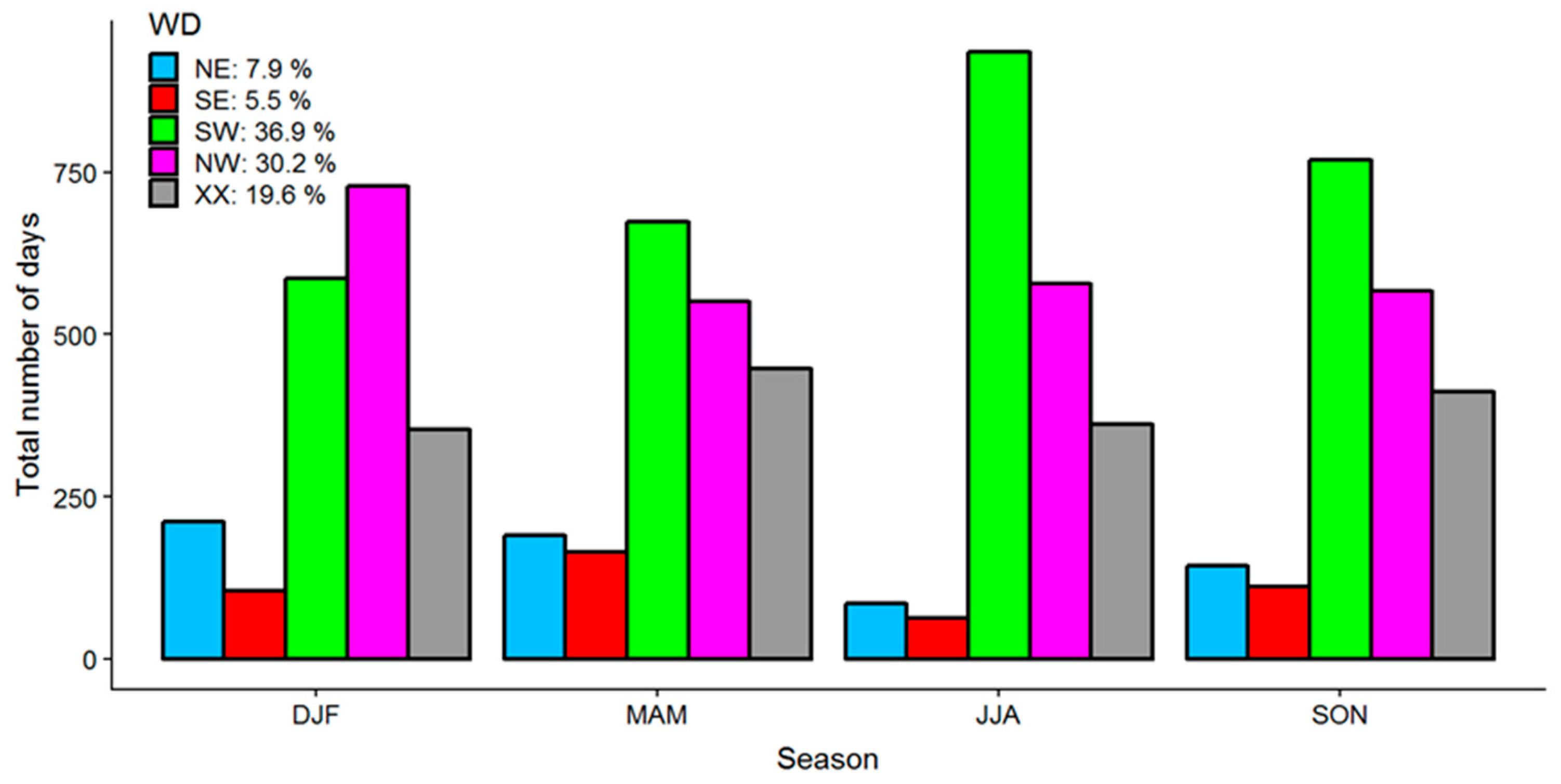
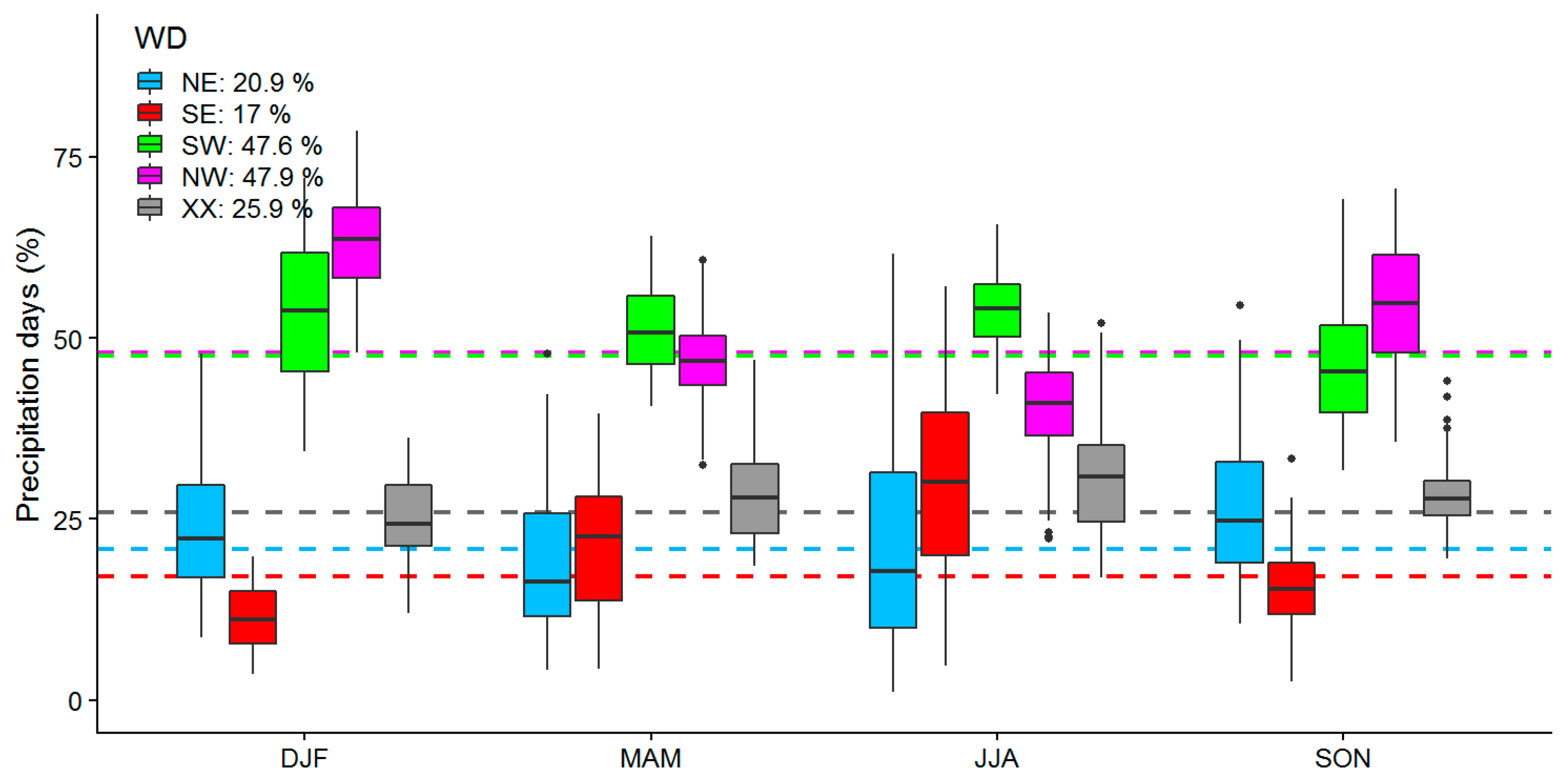
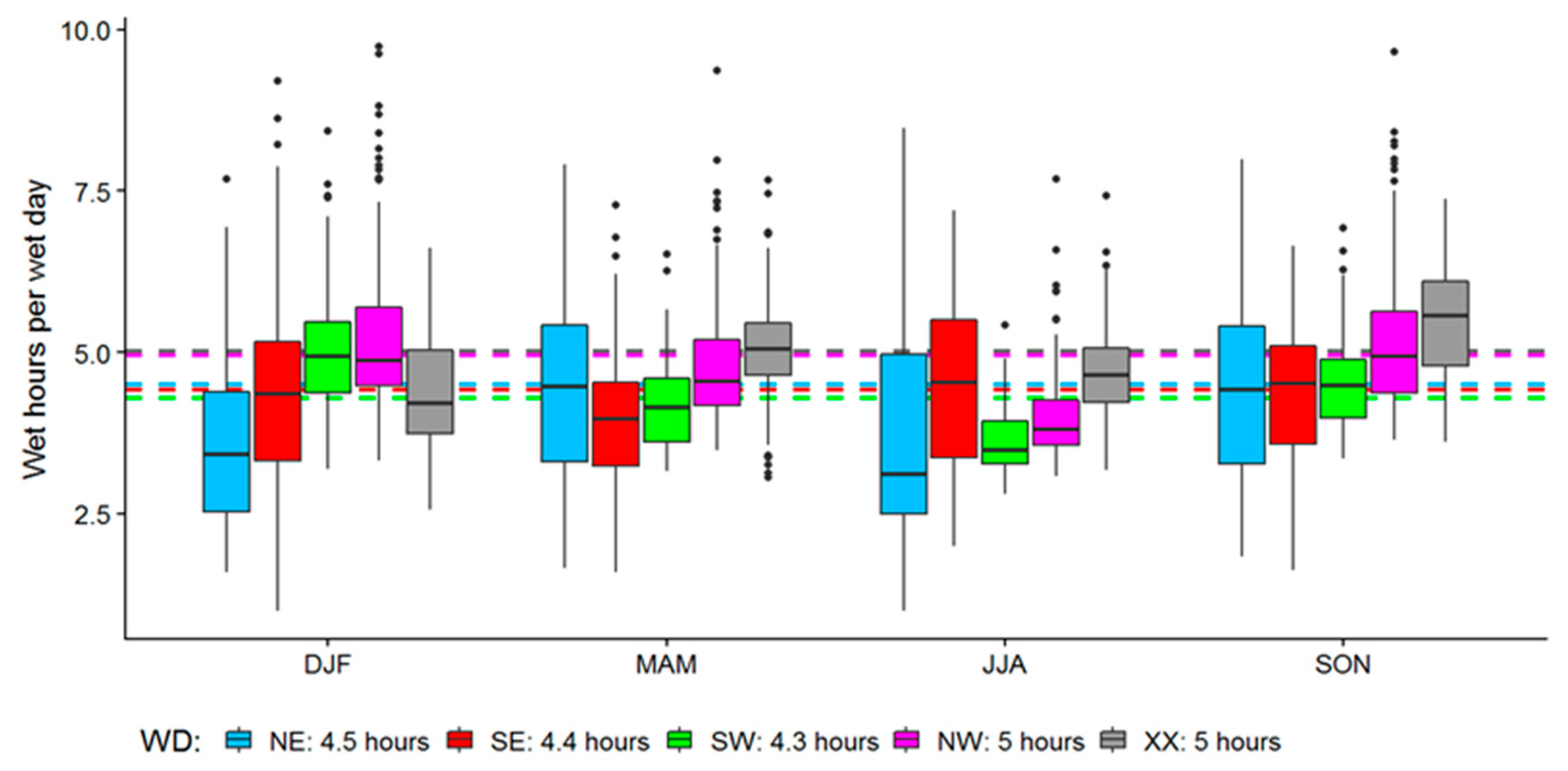
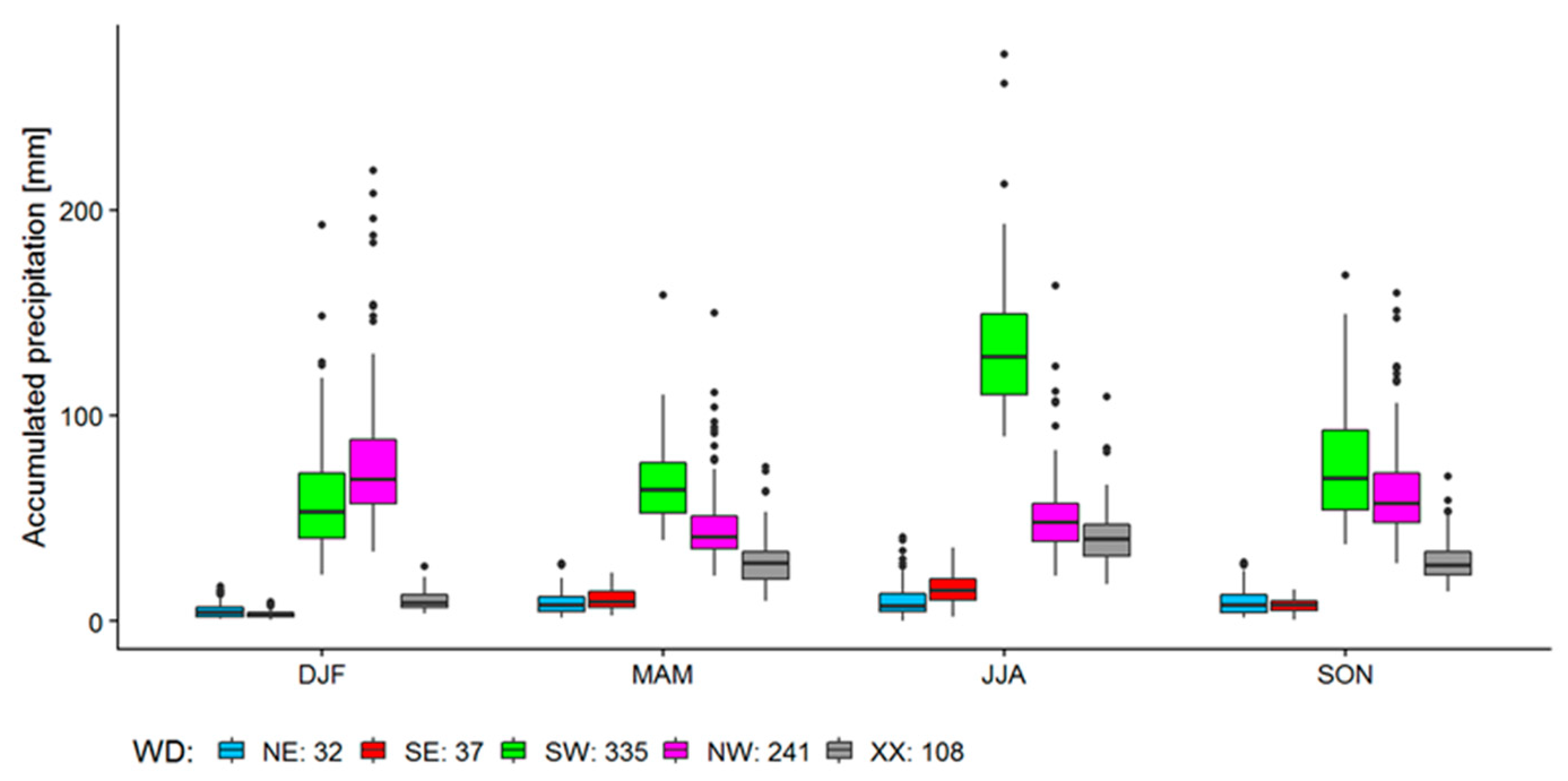
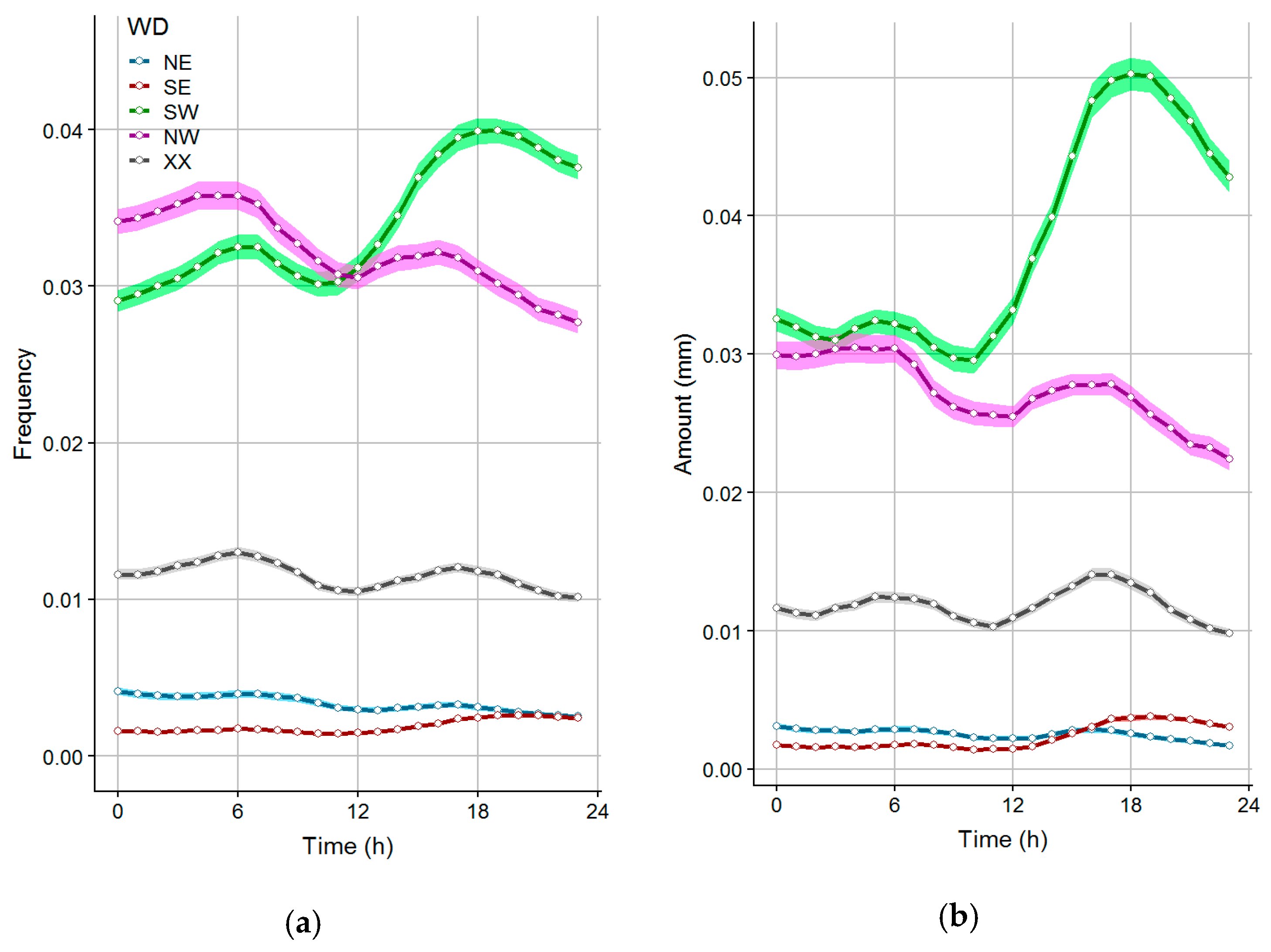
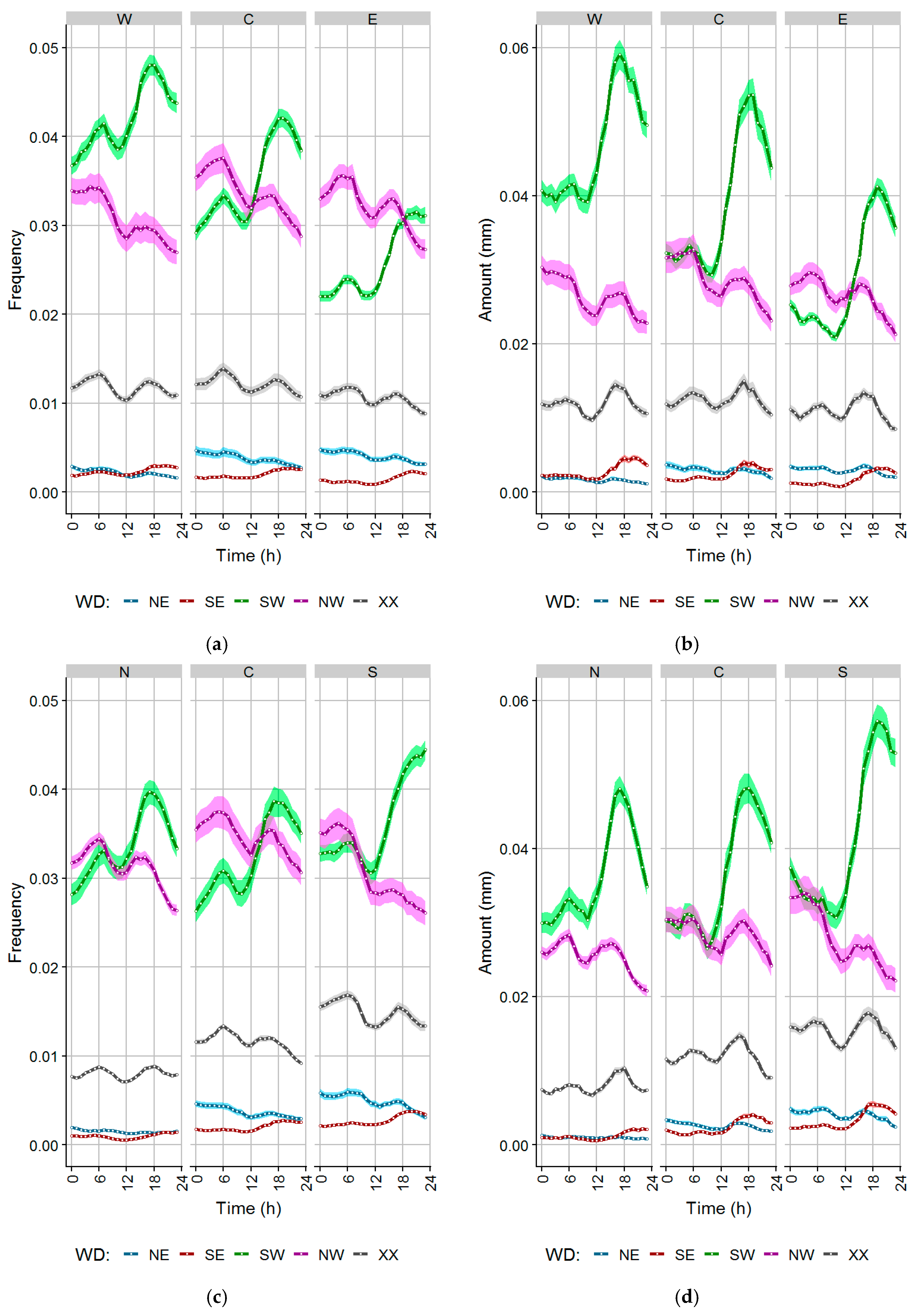
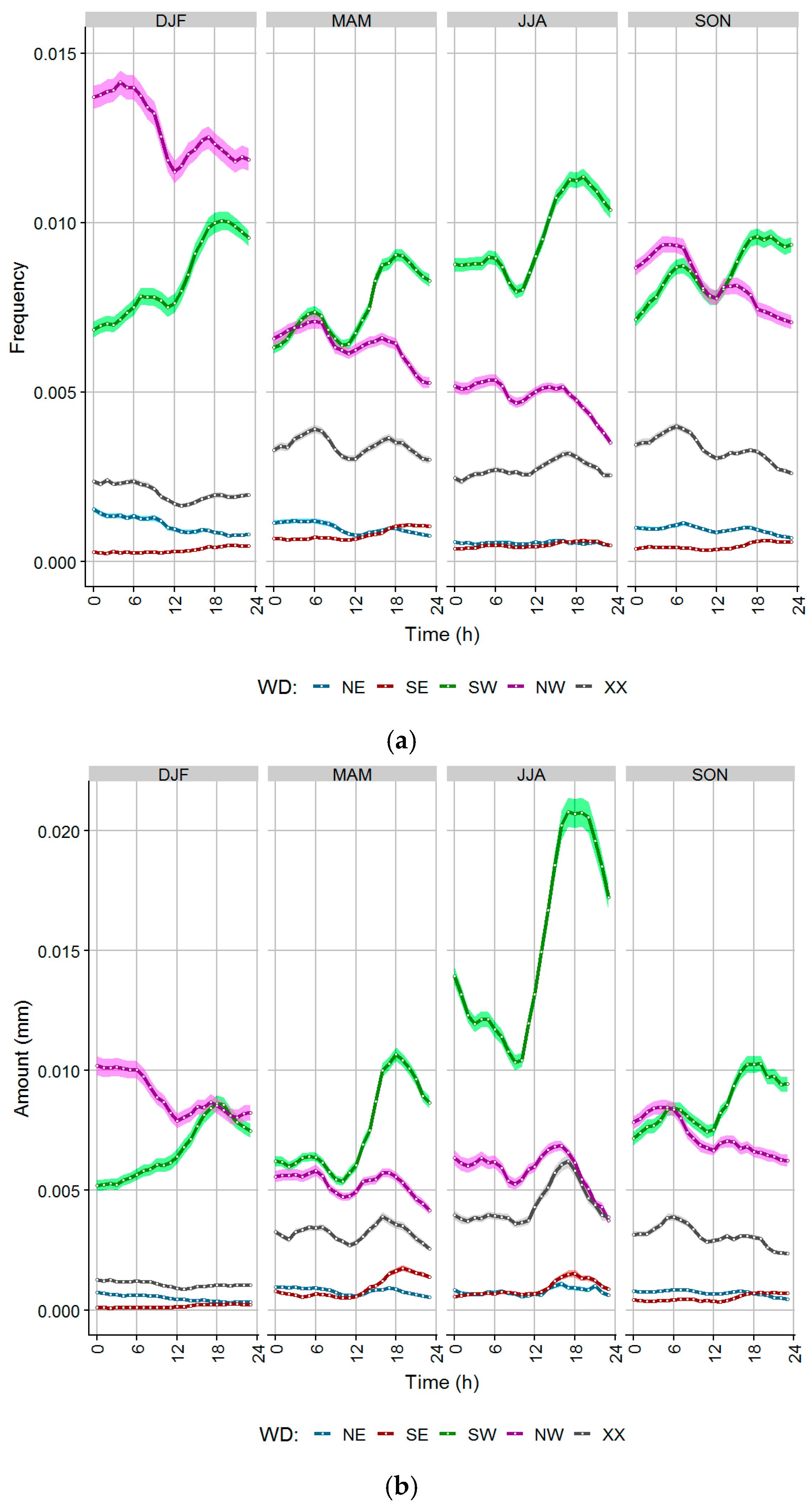
| Threshold | Class | Number of Stations | |
|---|---|---|---|
| Longitude (° E) | >11.5 | Eastern (E) | 46 |
| 9.4–11.5 | Central (C) | 48 | |
| <9.4 | Western (W) | 42 | |
| Latitude (° N) | >52 | Northern (N) | 45 |
| 50–52 | Central (C) | 46 | |
| <50 | Southern (S) | 45 | |
| Elevation (m a.s.l.) | >400 | High (H) | 43 |
| 100–400 | Medium (M) | 46 | |
| <100 | Low (L) | 47 |
© 2019 by the authors. Licensee MDPI, Basel, Switzerland. This article is an open access article distributed under the terms and conditions of the Creative Commons Attribution (CC BY) license (http://creativecommons.org/licenses/by/4.0/).
Share and Cite
Ghada, W.; Yuan, Y.; Wastl, C.; Estrella, N.; Menzel, A. Precipitation Diurnal Cycle in Germany Linked to Large-Scale Weather Circulations. Atmosphere 2019, 10, 545. https://doi.org/10.3390/atmos10090545
Ghada W, Yuan Y, Wastl C, Estrella N, Menzel A. Precipitation Diurnal Cycle in Germany Linked to Large-Scale Weather Circulations. Atmosphere. 2019; 10(9):545. https://doi.org/10.3390/atmos10090545
Chicago/Turabian StyleGhada, Wael, Ye Yuan, Clemens Wastl, Nicole Estrella, and Annette Menzel. 2019. "Precipitation Diurnal Cycle in Germany Linked to Large-Scale Weather Circulations" Atmosphere 10, no. 9: 545. https://doi.org/10.3390/atmos10090545
APA StyleGhada, W., Yuan, Y., Wastl, C., Estrella, N., & Menzel, A. (2019). Precipitation Diurnal Cycle in Germany Linked to Large-Scale Weather Circulations. Atmosphere, 10(9), 545. https://doi.org/10.3390/atmos10090545





